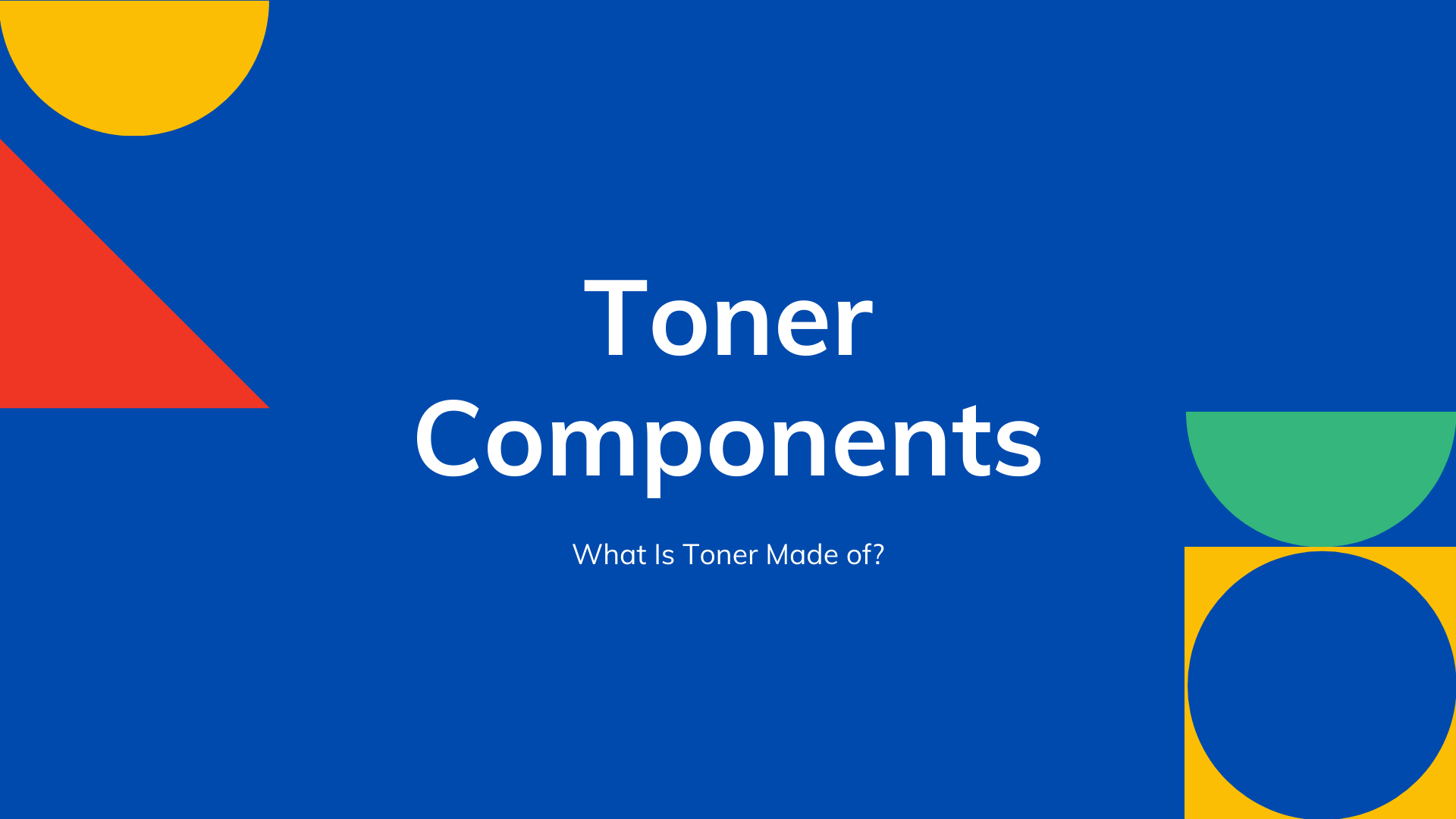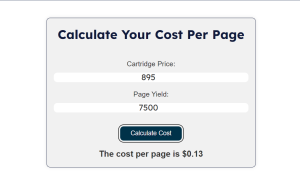CONTENTS:

CONTENTS:
✨ Quick Answer
The printer toner is made of a fine powder that includes plastic, color pigments, and small amounts of metal.
Toner Cartridge Contents: It’s Dust, Dude
Yeah, we know it’s dust, but dust from what?
The toner powder inside of cartridges is a proprietary formula specific to your brand of printer.
But there’s no great secret about the basic toner ingredients.
Toner dust is derived from specialized plastic particles that adhere to the paper and are melted into place by heat and pressure. (Who doesn’t love a toasty warm printout fresh from the Laserjet?)
Magic Dust, Bro
The finely powdered plastic in toner cartridges does not conduct electricity but is able to hold a static charge.
This means it can be moved around and positioned as an image on a charged drum roller.
Also, powdered plastic melts at a very low temperature, which makes fusion with heat and a pressure roller possible.
But What Is Printer Toner Made Of?
The printer toner consists of a finely ground mixture containing plastic, colorants, and trace metals. The process to create this powder involves a method that has been used for decades and remains in use today.
Toner was once — and frequently still— made from plastic slabs that are broken, crushed, and ground down into fine powder using air jet milling.
But that can yield unevenly sized particles, which results in less-than-perfect printed images.
This led toner manufacturers to “grow” uniform-sized toner particles in a lab.
These smaller, evenly sized particles permit better image reproduction and allow more efficient toner use:
Ancient Yearnings
Ever since early man used crushed berries to paint on cave walls, humanity has sought a better way to express itself through words and art.
We needed ink!
As early as the 4th century BC, Middle Eastern civilizations made ink from burned bones, pitch, and tar, while the ancient Chinese made ink from fish glue.
From squid ink to the development of carbon black — a powdered soot made from burnt tar and creosote — mankind is on a never-ending quest to find a better way to print.
Toner: A Better Ink
We’ve finally found a better type of ink for computer printers. It’s called toner.
Unlike ink cartridges, toner cartridges don’t dry out, produce more pages faster, and print sharper text (plus you can always sell toner if needed).
Toner is made from a dry powder, not liquid, which contributes to its longevity and prevents it from drying out or evaporating, a common issue with ink. This attribute makes toner well-suited for printers that aren’t used frequently.
Xerox engineer Gary Starkweather developed laser printing in 1969 by modifying one of the company’s office copiers.
Since then, laser printing is the good-to for high volume printing and low cost-per-page.
It may not seem like it when you’re buying OEM toner cartridges, but toner really is a better bargain than ink.
Despite the initial cost, toner, particularly the high-yield options like the HP 414X toner set, proves to offer more prints at a lower cost-per-page compared to ink cartridges.
If you don’t print often, budget-friendly, low-output ink cartridges might be more economical. But, if you print very infrequently, remember that ink can dry out. In such cases, toner could still be a better option.
To check your cost per page you can use our Printing Cost Calculator.

What’s On The Label?
Manufacturers use the same basic formulas when making color laser toners.
Yellow laser toners contain pigment yellow 180, magenta toners contain pigment red 122, while cyan toners contain pigment blue 15:3.
Black laser toners contain carbon black powder combined with powdered plastic.
What else is in there?
Fumed silica, which keeps the powdered toner particles loose and flowing freely inside the cartridge, and charge control agents — powdered iron, chromium, and zinc — which maintain the charge of the particles.
Mechanism of Toner Adhesion to Paper
The toner adheres to paper through a combination of heat and pressure in a process called fusing. In a laser printer, a laser beam first transfers an electrostatic image of the document onto a drum.
The toner powder, which is electrically charged, sticks to this electrostatic image. The paper then passes through the printer, where it comes into contact with the drum and picks up the toner.
Finally, the paper and toner pass through the fuser unit, where heat melts the toner and pressure bonds it onto the paper, creating a durable and smudge-resistant print.
Types of Toner Cartridges
When selecting toner cartridges, it’s important to understand the differences between the main types available:
- OEM Cartridges: These are Original Equipment Manufacturer cartridges, made by the same company that manufactures the printer. They are known for their reliability and high quality but come at a higher price point.
- Compatible Cartridges: Compatible cartridges, made by third-party manufacturers for specific printers, offer a cost-effective alternative to OEM cartridges. However, the toner used isn’t of the same patented quality as in OEM cartridges.
- Remanufactured Cartridges: These are recycled OEM cartridges that have been cleaned, repaired, and refilled with toner. They are eco-friendly, cutting down on waste and often costing less than OEM cartridges, while still delivering quality that can match brand-name versions.
Note: Users might pick compatible cartridges for their lower cost, but the potential quality issues could end up costing more than OEM cartridges in the long run.
For example, if a compatible cartridge leaks or produces poor-quality prints, it might necessitate reprints and even damage the printer, leading to additional expenses.
Furthermore, having to replace cartridges often because they run out quickly or don’t work well with the printer can also make overall costs go up.
Page Yields
When discussing page yields of toner cartridges, it’s helpful to consider the different types based on the volume of prints they offer:
- Standard Yield Cartridges: Designed for occasional or light printing needs, these cartridges typically offer around 1,000 to 1,500 pages. They have the lowest upfront cost but a higher cost per page compared to other types.
- High-Yield Cartridges: Ideal for moderate to heavy printing, high-yield cartridges contain more toner and can print about 2,500 to 3,500 pages, significantly more than standard cartridges, thus offering a better cost per page.
- Extra High-Yield Cartridges: Best suited for very high-volume printing environments, these cartridges can provide upwards of 4,000 to 10,000 pages, delivering the lowest cost per page and reducing the frequency of cartridge replacements.
The page yield numbers provided here are general estimates and can vary significantly between different printer models and manufacturers. For the most accurate and specific information on cartridge yields, please refer to the documentation provided by your printer or toner cartridge manufacturer.
Conclusion
Life inside a toner cartridge is indeed a wondrous place filled with magical science and fantastic technology, (as well as several human carcinogens).
Plastic dust is the simple answer to the question of what’s in your toner, but the technological advancements that got it there are truly amazing.
Further reading:
- How Long Does Printer Toner Last?
- How to Recycle Toner Cartridges for Cash?
- 7 Common Laser Printer Problems
References:
- https://www.verifiedmarketresearch.com/product/printing-toners-market/
- https://www.sphericalinsights.com/reports/printing-toners-market
Ted S. Leber
I am trying to print artwork on copper-clad PCB material to make printed circuit boards via the toner transfer method which is fairly common. I am trying to use an HP LaserJet P1102w printer which works very poorly for this application. I suspect that the HP toner in my CE285A cartridge has to small of a plastic component for this application. I know of one guy who uses an HP LaserJet 1100A with great success but that printer is no longer available although the toner is. Can I refill my HP CE285A cartridge with toner made for the HP C4092A cartridge without hurting my printer? if not, can you suggest a modern-day printer that might work for this application?
Rob Errera
Printing computer circuit boards at home is a rather specialized skill, Ted, but, from what we can gather, you can get the job done with a standard laser printer. We’re not sure how to get HP C4092A toner into a CE285A cartridge and we’re not sure you need to. It’s more important to use the right imaging software to render the fine lines required for PCB transfers. Also, the heat of your iron affects the transfer somewhere around 130-degrees F is probably right. You can learn more here.